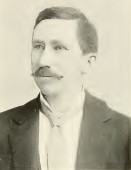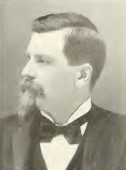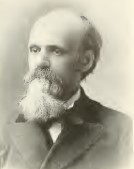|
Progressive Men
Index
 ERNEST R. GAYLORD, cashier of the
Metropolitan Bank of Minneapolis, is a younger man than
is usually found in stich an important position of
trust. He was born February 20, 1863, at Saugatuck,
Connecticut, a son of S. D. and Carrie Russell
(Gaylord). The Gaylords are one of the oldest
Connecticut families, the first member of which landed
there in 1631. When Mr. Gaylord was five years of age,
in 1868, his parents came to Minnesota and settled in
Blue Earth County. He remained there until the age of
fifteen, when he came to Minneapolis, and was here
afforded the better educational advantages of the public
schools of this city. ERNEST R. GAYLORD, cashier of the
Metropolitan Bank of Minneapolis, is a younger man than
is usually found in stich an important position of
trust. He was born February 20, 1863, at Saugatuck,
Connecticut, a son of S. D. and Carrie Russell
(Gaylord). The Gaylords are one of the oldest
Connecticut families, the first member of which landed
there in 1631. When Mr. Gaylord was five years of age,
in 1868, his parents came to Minnesota and settled in
Blue Earth County. He remained there until the age of
fifteen, when he came to Minneapolis, and was here
afforded the better educational advantages of the public
schools of this city.
He left school at the age of sixteen, and earned
his first money carrying papers for the Minneapolis
Tribune.
Subsequently he secured a position with Charles
Young, a job printer, in the old Brackett Block. Afterward he was
employed by E. P. Howell, boot and shoe dealer. He only
remained in that business for a short time, however,
when a better opening presented itself in the counting
room of Charles Heffelfinger, where he was employed for
a year. His next engagement was with Preston &
Knott, dealers in rubber goods, and afterwards with
Eichelzer & Co., dealers in men’s furnishing goods
and furs. He found a better opening, however, with V. G.
Hush, a private banker, and for a year was teller of the
Hush bank. He then connected himself with the
Northwestern National Bank, where he was engaged for six
years, the latter part of the time as teller. On the
organization of the Metropolitan Bank Mr. Gaylord was
offered the position of teller in that institution, and
held that position for a year, when he was promoted to
the duties of assistant cashier. Upon the
resignation of the cashier in 1892 Mr. Gaylord was
elected cashier, which position he now holds. He enjoys
a large acquaintance and great popularity among business
men, and conducts the duties of his responsible position
in such a way as to make many friends for the
institution with which he is connected.
He is a Republican in politics, but has never
taken any very active part in political affairs. He is a
member of the Masonic fraternity, as well as a member of
social and commercial clubs and societies. He was
married December 14, 1886. to Clara L. Weld, and has
one child, Marion M.
 GEORGE
FRANKLIN GETTY is a native of Grantsville, Maryland,
where he was born October 17, 1855. Mr. Getty’s father
was a farmer in moderate circumstances and died when the
subject of this sketch was quite young. GEORGE
FRANKLIN GETTY is a native of Grantsville, Maryland,
where he was born October 17, 1855. Mr. Getty’s father
was a farmer in moderate circumstances and died when the
subject of this sketch was quite young.
George Franklin received his early education in
the country schools of Eastern Ohio and was considered
an apt pupil at an early age, generally maintaining
himself at the head of his class. He took especial
interest in debating societies, both in the country
schools and in the academies which he afterwards
attended. He was a student of Smithville Academy, in
Wayne County, Ohio, in 1874, and in 1876 was enrolled as
a student at the Ohio Normal University. He attended
this institution at frequent intervals, his course being
interrupted by short terms of teaching in the country
and village schools. He graduated, however, from the
Normal University on July 10, 1879, in the scientific
department. This is a very successful school in point of
numbers, the largest, in fact, in Ohio. A prominent
feature of the literary work was the debating societies,
and in the exercises of these organizations Mr. Getty
took a prominent part. He represented the Philomathean
Society at every public contest and at every class
entertainment while he was a student at that
institution. He was salutatorian of his class on
graduation day.
In 1881 and 1882 he attended the law department
of Michigan University and was admitted to practice at
Ann Arbor in 1882. He began practicing shortly
afterwards at Caro, Michigan, where he continued until
1884. During his residence at Caro he was elected
circuit court commissioner for Tuscola County, a
profitable office for a young lawyer.
In 1884 he came to Minnesota and located in
Minneapolis, his change of residence being made on
account of his wife’s health. He has been successful in
his practice in Minnesota, making a specialty of life
insurance law, and has represented these companies as
general attorney in a number of important cases. His
practice extends over several states, including
Minnesota, Wisconsin, Iowa, the Dakotas, Colorado and
California. Among his important cases was one before the
supreme court of Wisconsin, which opened that state to
nearly all the leading fraternal insurance
organizations, such as Masons and Odd Fellows.
In politics Mr. Getty was originally a Democrat,
his ancestry having been adherents of that political
faith. His first vote, however, was cast for a
Republican, and he held office in Tuscola County as a
Republican. On his arrival in Minnesota he espoused the
cause of prohibition, and was an ardent and influential
leader in that movement. He was secretary of the state
central committee in the Fisk campaign of 1888, and at
the same time the editor of “The Review,” a party organ,
in this state. He was again secretary of the state
central committee when Hugh Harrison ran for governor on
the Prohibition ticket. Since then he has taken a less
active part in politics and has generally voted the
Republican ticket. Mr. Getty is a member of the North
Star Lodge, I. O. O. F., Minneapolis Lodge, St. John’s
Chapter, No. 9, Zion Commandery, No. 2, Minneapolis,
Zuhrah Temple, the Minneapolis Commercial Club, the
Minneapolis Bar Association and the Minnesota Bar
Association.
His church affiliations are with the Methodist
body and his membership is with the Wesley church in
Minneapolis. He was married in 1879 to Sarah C. Risher,
at Marion, Ohio.
They have had two children, Gertrude Lois, who
died October 10, 1890, and Jay Paul, who is
living.
 HENRY J. GJERTSEN is a native of
Tromsoe, Norway. His father was born in Bergen, Norway,
and comes from the well-known Gjertsen family of that
city. At an early age he removed to the northern part of
Norway, Tromsoe County, where he married Albertina,
daughter of the Wulf family, and engaged in agriculture
and shipping until about twenty-eight years ago, when he
brought his family to this country and settled in
Hennepin County. HENRY J. GJERTSEN is a native of
Tromsoe, Norway. His father was born in Bergen, Norway,
and comes from the well-known Gjertsen family of that
city. At an early age he removed to the northern part of
Norway, Tromsoe County, where he married Albertina,
daughter of the Wulf family, and engaged in agriculture
and shipping until about twenty-eight years ago, when he
brought his family to this country and settled in
Hennepin County.
The subject of this sketch was born
October 8, 1861, and was six years of age when his
parents came to this country. Mr. Gjertsen’s early
education was obtained in the district school in the
town of Richfield, Hennepin County, Minnesota, where his
father was engaged in farming. He grew up on the farm
until he was twenty years of age, working on the farm
during the summer season and attending school in the
winter. In this way he prepared for the Minneapolis high
school which he also attended for a time. Subsequently
he took a six years’ term in the collegiate department
of the Red Wing seminary, a theological institution. His
parents had destined him for the ministry, but after
completing his collegiate course he took up the study of
law in Minneapolis, and at the age of twenty-three was
admitted to practice by the district court of Hennepin
County.
While yet a student of law he
became interested in some important and fiercely
contested litigation which finally landed in the supreme
court and almost before he was regularly admitted to
practice he was recognized as an attorney of record in
the supreme court of Minnesota. He has also been
admitted to practice in the supreme court of the United
States. Mr. Gjertsen has
always been a student and speaks fluently the
Scandinavian and German languages. While very successful
in his professional work he retains a love for
agriculture and prides himself on being a practical and
thorough farmer. He has made no specialty of any
particular branch of law but has been engaged in general
practice and enjoys a reputation of a successful
practitioner, in both lower and higher courts. During
the last two years he has been engaged a greater part of
the time in prosecuting insolvency cases growing out of
the failures of the local banks.
Mr. Gjertsen is a Republican and
takes an active interest in local and national politics.
He has served at different times on county and
congressional committees, and takes an active part in
the work of the Republican League he was a delegate to
the last national convention of the Republican League;
has stumped the state in every direction for the last
ten years in the interest of the Republican ticket; has
been a delegate to several state conventions, but has
never held any political office, he is recognized as one
of the leading Scandinavians of the state, and his name
has been frequently mentioned for judicial honors. He is
a member of the A. F. and A. M., and
several other fraternal societies, local clubs and
organizations. He has taken an active interest in the
promotion of every enterprise inaugurated for the
benefit of the city.
In his church connections he is an
Episcopalian and an active member of that denomination.
Mr. Gjertsen was married
January 4, 1883, to Gretchen Goebel, daughter of a
prominent German family from Hanau, near
Frankfort-on-the-Main. He has one daughter living and is
thoroughly devoted to his family. He has resided in
Minneapolis ever since he was married, and is in every
way loyally identified with the interests of the
city.
 MELCHIOR FALK GJERTSEN is a Lutheran
clergyman of Minneapolis, more familiarly known as M.
Falk Gjertsen. His father, Johan P. Gjertsen, was also a
minister of the gospel and one of the organizers of the
“Zion Society for Israel,” a society for the conversion
of the Jews. Johan P. was also the author of “Missionary
Hymns for Israel.” He was held in high esteem by all who
knew him, and died in his ninetieth year at Stoughton,
Wisconsin. His wife’s maiden name was Bertha Johanna
Hanson. She is still living in her eighty-first year.
Mr. Gjertsen’s ancestors both on his father’s and on his
mother’s side belonged to the peasantry of Norway, and
he was born February 19, 1847, in Sogm, Norway. He
attended the Latin school or college at Bergen, Norway,
and at the age of seventeen came to America. MELCHIOR FALK GJERTSEN is a Lutheran
clergyman of Minneapolis, more familiarly known as M.
Falk Gjertsen. His father, Johan P. Gjertsen, was also a
minister of the gospel and one of the organizers of the
“Zion Society for Israel,” a society for the conversion
of the Jews. Johan P. was also the author of “Missionary
Hymns for Israel.” He was held in high esteem by all who
knew him, and died in his ninetieth year at Stoughton,
Wisconsin. His wife’s maiden name was Bertha Johanna
Hanson. She is still living in her eighty-first year.
Mr. Gjertsen’s ancestors both on his father’s and on his
mother’s side belonged to the peasantry of Norway, and
he was born February 19, 1847, in Sogm, Norway. He
attended the Latin school or college at Bergen, Norway,
and at the age of seventeen came to America.
He located in Chicago and contributed to the
support of the family by working in a chair factory,
where his daily task was to put together fifty-four
spindle chairs a day, for which he received one dollar.
After three months’ work there he found employment in a
shingle mill at one dollar and fifty cents a day. He was
afterwards offered and accepted a place in a Milwaukee
grocery store. After working there a year, he became ill
and was brought near to death’s door. It was at this
time that he resolved if he got well to change the whole
course of his life. On his recovery he began to study
for the ministry, and entered the theological seminary
of the Scandinavian Augustana Synod, at Paxton. Illinois. He was
ordained to the ministry in 1868, and was a pastor of
the church at Leland, Illinois, for four years: at
Stoughton, Wisconsin, nine years, and has been pastor of
the same church the Lutheran Trinity church, in
Minneapolis for fifteen years, having come to this city
in 1881. Mr. Gjertsen was one of the first promoters of
temperance work among the Scandinavians of the
Northwest, and the organizer of the Norwegian Y. M. C.
A. work. He
has also been deeply interested in hospital work, and in
the establishment here of the Order of Deaconesses.
Mr. Gjertsen is a very influential man among the
Scandinavians of Minnesota, and was selected in 1887 for
membership on the school board by both the Republicans
and Democrats. He is, however, a Republican, with a
strong sympathy for the cause of prohibition, and has
taken an active part in the fight against the liquor
traffic in this city. He was secretary of the school
board for six years, and in 1894 was reelected on both
the Republican and Prohibition tickets. He was then made
president of the board. As stated above, he is a member
of the Lutheran Church, in which he was baptized. He was
one of the organizers of the Norwegian-Danish Lutheran
Conference in 1870, and also of the United Norwegian
Lutheran Church of America, which was organized in 1890.
He was one of the founders and has always been one of
the most ardent supporters of Augsburg Theological
Seminary. Mr. Gjertsen was married in 1869 to Sara Ann
Mosey, of Freedom, Illinois. They have three children living. Marie, Johan and
Lena.
 JOHN
BACHOP GILFILLAN is a lawyer in
Minneapolis. His grand parents on
his father’s side emigrated from Balfron, Sterling,
Scotland, in 1794, and of his mother from Glasgow in
1795, and settled in Caledonia County, Vermont. JOHN
BACHOP GILFILLAN is a lawyer in
Minneapolis. His grand parents on
his father’s side emigrated from Balfron, Sterling,
Scotland, in 1794, and of his mother from Glasgow in
1795, and settled in Caledonia County, Vermont.
As the name indicates the
neighborhood was populated by emigrants from Scotland,
and here in the town of Barnet the subject of this
sketch was born February 11, 1835. His father, Robert
Gilfillan, was a farmer, and the early years of his
boyhood were spent on the farm, with attendance at the
district school in the winter. When he was twelve years
old his parents moved to the town of Peacham, and he
prepared himself for Dartmouth College at the Caledonia
Academy, located in that town. In order to contribute to
his own support he began teaching in the district
schools at the age of seventeen. His brother-in-law.
Captain John Martin, had settled in St. Anthony,
Minnesota, and Mr. Gilfillan came to visit him in
October, 1855, hoping to obtain a position as teacher,
but expecting to return later and enter college. The
position as teacher was obtained, and the attractions of
the West proved to be so strong that he never returned
to college.
He began the study of law with
Nourse & Winthrop, afterwards with Lawrence &
Lochren. and in 1860 was admitted to the bar. He formed
a partnership with J. R. Lawrence, which continued until
his partner entered the army. Mr. Gilfillan then
practiced law alone until 1871, when the firm of
Lochren, McNair & Gilfillan was formed.
Judge Lochren was subsequently appointed to the
district bench, and Mr. McNair died in 1885.
In 1885, the present firm of Gilfillan, Belden
& Williard was formed. Mr. Gilfillan, and the firms
with which he has been connected have enjoyed a large
share of the most lucrative and important law practice
in the state. Among the important cases in which he was
engaged were the contested will cases of Stephen
Emerson, Ovid Pinney and Governor C. C. Washburn. He has
also been engaged as an attorney of the Chicago,
Milwaukee & St. Paul Railroad; Chicago, St. Paul,
Minneapolis & Omaha Railroad, and the Minneapolis
Eastern Railroad. Mr. Gilfillan has always taken an
active interest in educational matters. As early as 1859
he helped to organize the Mechanics’ Institute for
Literary Culture, in St. Anthony.
He drew up the bill for the organization of the
St. Anthony school board, under which the system of
graded schools was introduced, and served as a director
for nearly ten years.
In 1880 he was appointed regent of
the state university, and served in that position for
eight years. Mr. Gilfillan has always been a Republican
in politics, and has held several offices, beginning
with that of city attorney of St. Anthony soon after his
admission to the bar. He was elected county attorney of
Hennepin County in 1863, and served until 1867; again
from 1869 to 1871, and from 1873 to 1875. In 1875 he was
elected to the upper house of the state legislature, and
served in that capacity for ten consecutive years.
In the earlier years of his service in the senate
he was chairman of the committee on taxes and tax laws,
and raised these laws into a code which constitute the
chief body of the revenue system of the state. Perhaps
the most important piece of legislation in which he
performed a leading part was that providing for the
adjustment of the state railroad bonds. He in fact
dictated the terms of the compromise bill which became
the law upon which the adjustment was made.
In 1884 Mr. Gilfillan was elected
to congress from the district then including both
Minneapolis and St. Paul on the expiration of his term
of office Mr. Gilfillan took his family to Europe and
having placed his children in school in Dresden, spent
nearly two years and a half in travel, visiting every
country of Europe except Portugal, and extending his
travels into Egypt and the Holy Land. He then returned
to the practice of his profession in Minneapolis, in
which he is now actively engaged.
He is a member and an officer of Westminster
Presbyterian Church. Mr. Gilfillan was married in 1870
to Miss Rebecca C. Oliphant, of Fayette County,
Pennsylvania. He has four children living. The mother
died March 25, 1884. In June, 1893, Mr. Gilfillan was
married to Miss Lavinia Coppock, of New Lisbon, Ohio,
but more recently of Washington, D.
C.
 JOHN FINLEY GOODNOW traces his descent from
the Harrison who signed the Declaration of Independence.
He is of English and Scotch-Irish ancestry, the son of
James Goodnow and Nancy T. Lattimore (Goodnow). He was
born June 29, 1858, at Greensburg, Indiana. His parents
came to Minneapolis in 1870, and he attended the public
schools of this city until 1875, when he graduated from
the high school.
He then entered the University of Minnesota, from
which he graduated in 1879. Mr. Goodnow was the chemist
in the state board of health subsequent to his
graduation from the university. He studied
medicine with Dr. Hewitt, president of the state board
of health, in Red Wing for two years. He did not pursue
the practice of medicine, however, but returned to
Minneapolis and engaged in the lumber and fuel business
in which he has been interested for fifteen years. JOHN FINLEY GOODNOW traces his descent from
the Harrison who signed the Declaration of Independence.
He is of English and Scotch-Irish ancestry, the son of
James Goodnow and Nancy T. Lattimore (Goodnow). He was
born June 29, 1858, at Greensburg, Indiana. His parents
came to Minneapolis in 1870, and he attended the public
schools of this city until 1875, when he graduated from
the high school.
He then entered the University of Minnesota, from
which he graduated in 1879. Mr. Goodnow was the chemist
in the state board of health subsequent to his
graduation from the university. He studied
medicine with Dr. Hewitt, president of the state board
of health, in Red Wing for two years. He did not pursue
the practice of medicine, however, but returned to
Minneapolis and engaged in the lumber and fuel business
in which he has been interested for fifteen years.
Mr. Goodnow takes an especial interest in
politics and has exerted a large influence in the
Republican party of this city and state during the last
ten years. He is now president of the state Republican
League, and has held that office for two terms. He has
been a member for three terms of the Republican state
central committee; has been chairman of the city
Republican committee, and has been twice chairman of the
resolutions committee of the National Republican League,
and is vice president of the National Protective Tariff
League. He
is regarded as one of the most skillful and successful
leaders of the Republican party in this state, and has
achieved a national reputation through his connection
with the National League of Clubs, and through his
activity for the nomination of William McKinley. At the
national convention of this organization in 1895, at
Cleveland, he was urged to accept the presidency, but
was obliged to decline on account of his business
interests. To his skill in shaping the deliberations of
the platform committee of the league at the Denver
convention in 1894 is attributed in a large degree the
harmonious and satisfactory outcome of that meeting. Mr.
Goodnow has never asked for any political office for
himself, choosing rather to serve his party in the
capacity of an adviser and in working in its interests.
He is a Mason, a Knights Templar and Shriner, and while
a student in the university he was a member of the Chi
Psi fraternity. He was also elected a member of the
honorary society of Phi Beta Kappa in recognition of his
scholarship and attainments as a student, and in 1895
was a delegate of the university chapter to the
triennial conference. He is also a member of the social
order of Hoo Hoos, where his geniality and good
fellowship make him a welcome addition.
He is an attendant of the Westminster
Presbyterian Church. Mr. Goodnow was married October 5.
1881, to Mary E. Hamilton, who died June 15, 1890. Their
living children are two
sons.
The information
on Trails to the Past © Copyright
may be used in personal family history research, with
source citation. The pages in entirety may not be
duplicated for publication in any fashion without the
permission of the owner. Commercial use of any material
on this site is not permitted. Please respect the
wishes of those who have contributed their time and
efforts to make this free site possible.~Thank
you! | | | |



